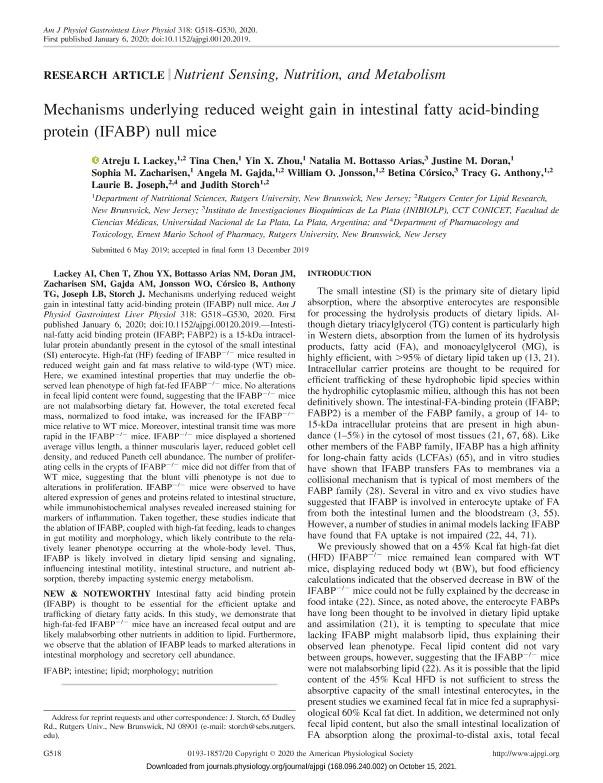Mostrar el registro sencillo del ítem
dc.contributor.author
Lackey, Atreju I.
dc.contributor.author
Chen, Tina
dc.contributor.author
Zhou, Yin X.
dc.contributor.author
Bottasso Arias, Natalia María

dc.contributor.author
Doran, Justine M.
dc.contributor.author
Zacharisen, Sophia M.
dc.contributor.author
Gajda, Angela M.
dc.contributor.author
Jonsson, William O.
dc.contributor.author
Córsico, Betina

dc.contributor.author
Anthony, Tracy G.
dc.contributor.author
Joseph, Laurie B.
dc.contributor.author
Storch, Judith
dc.date.available
2021-10-15T12:49:25Z
dc.date.issued
2020-02-27
dc.identifier.citation
Lackey, Atreju I.; Chen, Tina; Zhou, Yin X.; Bottasso Arias, Natalia María; Doran, Justine M.; et al.; Mechanisms underlying reduced weight gain in intestinal fatty acid-binding protein (IFABP) null mice; American Physiological Society; American Journal of Physiology-gastrointestinal and Liver Physiology; 318; 3; 27-2-2020; G518-G530
dc.identifier.issn
0193-1857
dc.identifier.uri
http://hdl.handle.net/11336/143771
dc.description.abstract
Intestinal- fatty acid binding protein (IFABP; FABP2) is a 15-kDa intracellular protein abundantly present in the cytosol of the small intestinal (SI) enterocyte. High-fat (HF) feeding of IFABP-/- mice resulted in reduced weight gain and fat mass relative to wild-type (WT) mice. Here, we examined intestinal properties that may underlie the observed lean phenotype of high fat-fed IFABP-/- mice. No alterations in fecal lipid content were found, suggesting that the IFABP-/- mice are not malabsorbing dietary fat. However, the total excreted fecal mass, normalized to food intake, was increased for the IFABP-/- mice relative to WT mice. Moreover, intestinal transit time was more rapid in the IFABP-/- mice. IFABP-/- mice displayed a shortened average villus length, a thinner muscularis layer, reduced goblet cell density, and reduced Paneth cell abundance. The number of proliferating cells in the crypts of IFABP-/- mice did not differ from that of WT mice, suggesting that the blunt villi phenotype is not due to alterations in proliferation. IFABP-/- mice were observed to have altered expression of genes and proteins related to intestinal structure, while immunohistochemical analyses revealed increased staining for markers of inflammation. Taken together, these studies indicate that the ablation of IFABP, coupled with high-fat feeding, leads to changes in gut motility and morphology, which likely contribute to the relatively leaner phenotype occurring at the whole-body level. Thus, IFABP is likely involved in dietary lipid sensing and signaling, influencing intestinal motility, intestinal structure, and nutrient absorption, thereby impacting systemic energy metabolism.
dc.format
application/pdf
dc.language.iso
eng
dc.publisher
American Physiological Society

dc.rights
info:eu-repo/semantics/openAccess
dc.rights.uri
https://creativecommons.org/licenses/by-nc-sa/2.5/ar/
dc.subject
IFABP
dc.subject
INTESTINE
dc.subject
LIPID
dc.subject
MORPHOLOGY
dc.subject
NUTRITION
dc.subject.classification
Otras Ciencias Naturales y Exactas

dc.subject.classification
Otras Ciencias Naturales y Exactas

dc.subject.classification
CIENCIAS NATURALES Y EXACTAS

dc.title
Mechanisms underlying reduced weight gain in intestinal fatty acid-binding protein (IFABP) null mice
dc.type
info:eu-repo/semantics/article
dc.type
info:ar-repo/semantics/artículo
dc.type
info:eu-repo/semantics/publishedVersion
dc.date.updated
2021-09-06T17:27:07Z
dc.identifier.eissn
1522-1547
dc.journal.volume
318
dc.journal.number
3
dc.journal.pagination
G518-G530
dc.journal.pais
Estados Unidos

dc.journal.ciudad
Bethesda
dc.description.fil
Fil: Lackey, Atreju I.. Rutgers University; Estados Unidos. Rutgers Center for Lipid Research; Estados Unidos
dc.description.fil
Fil: Chen, Tina. Rutgers University; Estados Unidos
dc.description.fil
Fil: Zhou, Yin X.. Rutgers University; Estados Unidos
dc.description.fil
Fil: Bottasso Arias, Natalia María. Consejo Nacional de Investigaciones Científicas y Técnicas. Centro Científico Tecnológico Conicet - La Plata. Instituto de Investigaciones Bioquímicas de La Plata "Prof. Dr. Rodolfo R. Brenner". Universidad Nacional de la Plata. Facultad de Ciencias Médicas. Instituto de Investigaciones Bioquímicas de La Plata "Prof. Dr. Rodolfo R. Brenner"; Argentina
dc.description.fil
Fil: Doran, Justine M.. Rutgers University; Estados Unidos
dc.description.fil
Fil: Zacharisen, Sophia M.. Rutgers University; Estados Unidos
dc.description.fil
Fil: Gajda, Angela M.. Rutgers University; Estados Unidos. Rutgers Center for Lipid Research; Estados Unidos
dc.description.fil
Fil: Jonsson, William O.. Rutgers University; Estados Unidos. Rutgers Center for Lipid Research; Estados Unidos
dc.description.fil
Fil: Córsico, Betina. Consejo Nacional de Investigaciones Científicas y Técnicas. Centro Científico Tecnológico Conicet - La Plata. Instituto de Investigaciones Bioquímicas de La Plata "Prof. Dr. Rodolfo R. Brenner". Universidad Nacional de la Plata. Facultad de Ciencias Médicas. Instituto de Investigaciones Bioquímicas de La Plata "Prof. Dr. Rodolfo R. Brenner"; Argentina
dc.description.fil
Fil: Anthony, Tracy G.. Rutgers University; Estados Unidos. Rutgers Center for Lipid Research; Estados Unidos
dc.description.fil
Fil: Joseph, Laurie B.. Rutgers Center for Lipid Research; Estados Unidos. Rutgers University; Estados Unidos
dc.description.fil
Fil: Storch, Judith. Rutgers University; Estados Unidos. Rutgers Center for Lipid Research; Estados Unidos
dc.journal.title
American Journal of Physiology-gastrointestinal and Liver Physiology

dc.relation.alternativeid
info:eu-repo/semantics/altIdentifier/doi/http://dx.doi.org/10.1152/ajpgi.00120.2019
dc.relation.alternativeid
info:eu-repo/semantics/altIdentifier/url/https://journals.physiology.org/doi/full/10.1152/ajpgi.00120.2019
Archivos asociados
